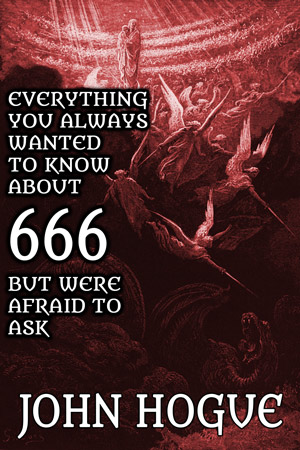
Click on this link and enjoy a meeting of humor and prophetic hubris–Bible style.
Friends,
More interesting comments come in about that most pesky of Gematrian prophecy numbers said to count out the name of the Beast in The Book of Revelation: 666 and its little brother 616. A strong prodding from its author, a certain John, locked away under arrest in a cave in that Greek island of Patmos in the Aegean no later than 70 AD, turns the Greek spellings of two Roman Emperors, Nero or Caligula, into the above numbers as the mark of the beast.
One reader of my blog entry of 29 March (What the Heck is 666 About?) asked the following:
MANDIE:
If 616 represents Caligula, then what about the “mark”…that no one can buy or sell without it?
HOGUE:
Let us look at the word “mark.”
There are the usual etymological mainstream understandings: A sign, symbol or visible impression. A visible trace or impression on something. A line, a spot, a signature. Alternatively, it is a number, a letter, a name, inscription, stamp, label, or seal placed on an article to signify ownership, quality manufacture, or origin?
Let us go deeper into the meaning…
With the German “Mark” the word is used to represent money, coins.
The mark was also the term for a monetary unit of the English and the Scotts. There is the Finnish “markka.” The usage of “mark” as a sign of quality, value, i.e. “money” or currency spans all Germanic and Romance languages.
If that is not already “all Greek to you” let’s look at the word St. John of Patmos uses in the original Greek for “mark”. It is not “stigma.” It is “Charagma.” It is not a stigmatic nick, brand burned into skin, a scar of service, etc. The mass murderer Charles Manson scratched a “stigmata” of the Swastika between his eyes. A “charagma” of the Beast is something else.
Terry Watkins in his article “Is the biochip the Mark of the Beast?” is right to cite Vine’s Expository Dictionary of Biblical Words for the correct definition as a “stamp, or an impress.” Although he goes on to think such a term is strong evidence for a “mark” or “stamp” of some future Antichrist’s biochip implant, I would counter that the meaning equally applies to something more ancient, such as a stamp, or mark of a coin. The “mark” of the beast would have the image of the Emperor Caligula (if the right number of the beast stands for “Kaligula Kaisar” [Caesar] in Greek–616), or it is Emperor Nero (“Neron Kaisar” [Caesar] in Greek–666).
What are these couple of Johns proposing?
John of Hogue typing on a glowering screen in the 21st century. John of Patmos gazing into the black recesses of his cave in the First Century, scratching out with ink in an inky black cave beyond the bright oasis of candlelight. The emperor Nero or Caligula’s minter coin stamping the mark of their brazen images on right hands and foreheads?
Hogue can only sit on his own John and make him share this Revelation:
The assumption we would all like to make is that St. John of Patmos was interpreting his visions rationally. The very nature of what he writes is a narrative of almost psychotic irrationality. If there are dragon-like creatures with many heads, there could be psychotic episodes of prophetic vision where coin images are stamped on the heads and on the hands of citizens of the Beast.
Sometimes what sounds futuristic is just plain crazy talk.
It is something to pause and reflect on, before we just gobble up any futuristic sounding bit of prophecy as a medium’s morsel about “our” future.
On the topic of Antichrists, I think Nostradamus, being born a little closer to a future-theme of this prophecy may have seen more details John of Patmos did not.
Therefore, I hope those among my readership who have not already gone there check out my new book that reports on a 21-year search for the Antichrist as Nostradamus visualized him: click on Nostradamus
John Hogue
(07 April 2009)
LIKE FACEBOOK PAGE * Join Free Newsletter
RSS Links * Hogue’s Author Page
Support HogueProphecy
GET AN ONLINE READING WITH JOHN HOGUE
Email him at hoguebulletin@hogueprophecy.com
Put “Hogue Reading” in Subject line
He’ll send you times, prices and information.